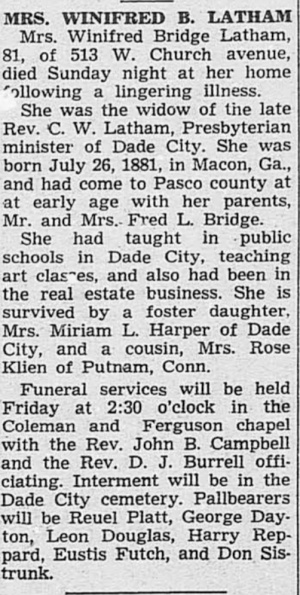HISTORY OF PASCO COUNTYWinifred Bridge (1881-1963) This page was created on June 1, 2016. Winifred Bridge Knew of Beauty, Life, TragedyThis article appeared in the Tampa Tribune on July 28, 1980. By GEOFFREY POUNDS DADE CITY — Winifred “Winnie” Bridge Latham died alone in her big home on Church Street in April of 1963, the victim of lingering illness and unmet dreams. In her 81 years, Winnie came to know these things because each was a part of her life. She left to others a glimpse of that life in her diary, her writings and her pictures, now the property of the Pioneer Florida Museum. “It’s kind of a tragedy, the way she died … a recluse,” said Bill Dayton, an east Pasco history buff. Dayton said he remembers as a young boy passing by the home of Winnie. The home was directly across from the Presbyterian Church and is no longer standing. The kids would peer through the overgrown garden into the frame home out of curiosity, said Dayton. “The place looked like a jungle and there were cats and dogs all over. Only once in a while would you see her. She’d pull back the curtain a little and peek out. But most people never saw her in her later years. She stayed in that house alone and very rarely came out,” he said. Dewey Hudson of Dade City remembers Winnie in a different light. Hudson first met her when he was one of her second-grade pupils back in 1906. “She is not hard to remember. I think that is because she was so refined and polished, she stuck out that way. She was an excellent teacher and an elegant lady,” Hudson said.  Much of the polish and sophistication of Winnie came from her father, Fred Bridge, probably the strongest influence in her life. Bridge, a businessman, came to Pasco County in the 1880s via Georgia, where Winnie was born. He was from Massachusetts. He, his wife, Katharine Amanda, and only-child Winnie settled in the now defunct town of Leonard [should be Lenard], near Trilby. They later moved to Dade City. A well-read and educated man, Bridge was not warmly greeted by all his new neighbors, for he had served as a captain in the Union Army during the Civil War. “That was cause enough for strong bitterness among the crackers,” said Dayton, “ but he also was different from his neighbors in that he subscribed to a number of literary magazines and publications from all over the country.” Those who knew the Bridge family, said Dayton, have related stories about the manner in which prejudice against them was displayed. “Walking down the street, some would cross over to the other side to avoid walking in front of the Bridge’s home. I understand people told their daughters to stay clear of Captain Bridge,” said Dayton, adding, “I also think the family’s views on things were more liberal than was generally accepted.” But despite the antipathy of a few jealous neighbors, Winnie had gained the respect of those who passed on the qualifications of teachers. In 1903, Winnie was granted a teacher’s certificate and assigned a class of 50 elementary-age students. Teaching would be her career for two decades. “Miss Winifred Bridge is a young lady of exceedingly high character and exalted views of duty. Her work is characterized by fidelity, patience, duty in every detail,” stated a school report published in the “Dade City Democrat” three years after Winnie began teaching. The early years of Winnie’s teaching career were eventful, her diary reports. In the winter of 1904, for example, more than half of her class missed much of the school year because of measles. Two years later, a vicious tropical storm hit the area, damaging the citrus and turpentine industry. Many of the stronger boys had to be excused from classes in order to help clean up the debris and repair the damage, she noted. By 1907, Winnie had decided to share her artistic talents and enlist the talents of her students and community members. Thus, she started the “Art Student Magazine,” an ambitious, if shortlived, project. The magazine featured illustrations inspired by and sometimes copied from the literary magazines that her father subscribed to. Using the box camera and the still camera given to her by her father, Winnie did much of her photographic work from 1905 to 1910. The still camera required glass negatives. “Her favorite subjects were her parents, self-portraits and shots with animals,” said Dayton, who managed to preserve a collection of Winnie’s photographs. “She liked animals so much that on some of her pictures she wrote the names of the pets pictured, but neglected to name the people in the photos,” he said. Outside the classroom, Winnie found plenty of events to record in her diary. The Dade City baseball team played Plant City three times in 1906, losing twice. Of that, Winnie wrote, “unfortunate occurrences.” Also in 1906, a horseless carriage was spotted on the streets of Dade City and duly recorded by Winnie. “Yes! There was an automobile in town today (Nov. 30) … Papa saw it. But I didn’t!” she wrote. The idea of a car so thrilled Winnie that four years later she bought one of her own, following the lead of Chris Lock, the man reported to have owned the first car in Dade City. Winnie was 25 in 1906 and her diary entries at that time are full of the accounts of the weddings of girlfriends her age. But there is little mention of her own romances. One entry that year perhaps tells why. “There is going to be a circus in town Friday — a somewhat sorry affair from what I hear, but I want to go — if my ‘best fellow’ asks me, she wrote. The invitation never came. In 1920, the 19th amendment was passed, giving women the right to vote. It was a victory hailed by Winnie. “The reason for the women’s movement, as for all great movements, is social advantage. …” But while she was dreaming of a softer world for others, Winnie’s own world was becoming increasingly harsh and lonely. In 1922 her father died and her mother’s health grew worse, forcing Winnie to leave her teaching career. A few years later her mother died. The losses took their toll. “This is all very hard. I’m afraid I’m losing control of my mind,” a diary entry reads. Winnie overcame her depression, however, and in 1933 at the age of 52, she married the Rev. C. W. Latham, a Presbyterian minister. Latham died only three years after marrying Winnie. It was after his death that Winnie slipped into the life of a recluse, staying in her home mostly and peeking out from behind the curtain. Her diary shows no further entries until 1955. She writes that year in last the entry that she was to make, “It is sad to think of all that has happened in fifty years. I am alone now and almost helpless.” Eight years later, she died.  |
